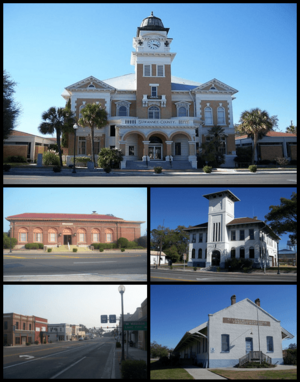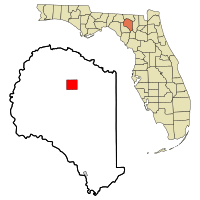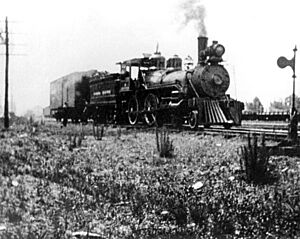Live Oak, Florida facts for kids
Quick facts for kids
City of Live Oak
|
||
|---|---|---|
| Live Oak, Florida | ||

Suwannee County Courthouse, Old Post Office, Old Live Oak City Hall, Downtown Live Oak, ACL Freight Station
|
||
|
||
| Nickname(s):
The City of Nature
|
||
| Motto(s):
"A Caring Community"
"Heart of the Suwannee River Valley" "In God We Trust" |
||

Location in Suwannee County and the state of Florida
|
||
| Country | ||
| State | ||
| County | Suwannee | |
| Incorporated (town) | 1878 | |
| Incorporated (city) | 1903 | |
| Government | ||
| • Type | Mayor–Council | |
| Area | ||
| • Total | 7.63 sq mi (19.76 km2) | |
| • Land | 7.63 sq mi (19.76 km2) | |
| • Water | 0.00 sq mi (0.01 km2) | |
| Elevation | 105 ft (32 m) | |
| Population
(2020)
|
||
| • Total | 6,735 | |
| • Density | 882.82/sq mi (340.87/km2) | |
| Time zone | UTC-5 (Eastern (EST)) | |
| • Summer (DST) | UTC-4 (EDT) | |
| ZIP codes |
32060, 32064
|
|
| Area code(s) | 386 | |
| FIPS code | 12-40875 | |
| GNIS feature ID | 0285862 | |
| Website | www.cityofliveoak.org | |
Live Oak is a city in Florida, United States. It's the main city, or county seat, of Suwannee County, Florida. The city is located about halfway between Tallahassee and Jacksonville. In 2020, about 6,735 people lived there.
Major roads like U.S. Highway 90, U.S. Highway 129, and Interstate 10 pass through Live Oak. The city also has train services for goods, provided by the Florida Gulf & Atlantic Railroad. For air travel, there's the Suwannee County Airport.
Did you know there's another community called Live Oak in Washington County, Florida?
Contents
History of Live Oak
Live Oak began shortly before the American Civil War. It was founded in 1858. The city was built where two important railways met. One railway went between Jacksonville and Tallahassee. The other ran south from Dupont, Georgia.
The city got its name from a large live oak tree. This tree was a popular spot for railway workers to gather and rest. It was located near the tracks. Today, a store called Pepe's Mexican Grocery stands where the famous tree once was.
In 1879, a school for Black teachers was started in Live Oak. This school later became Florida Memorial University, which is now in Miami.
Geography and Nature
Live Oak is located in Suwannee County, Florida. This area sits on a limestone bed. This limestone has many underground freshwater streams. These streams come to the surface as beautiful springs. This natural feature is called "Karst topography". It provides the area with fresh water and great places for fishing.
The county is famous for cave diving. This is where people SCUBA dive into underwater caves. Sheck Exley, a well-known underwater cave explorer, lived here. He wanted to be close to the many springs.
You can find several small lakes about 5 miles east of Live Oak. Suwannee Lake is the most popular for fishing. Other lakes include Workman Lake, Dexter Lake, and Tiger Lake.
The Twin Rivers State Forest is also nearby. It's a large Florida State forest, covering about 14,882 acres (60.22 km2).
Climate in Live Oak
Live Oak gets rain on about 84 days each year. This means it has the fewest rainy days in Florida. A rainy day is counted when more than 0.1 inches of rain falls.
People of Live Oak
| Historical population | |||
|---|---|---|---|
| Census | Pop. | %± | |
| 1880 | 458 | — | |
| 1890 | 687 | 50.0% | |
| 1900 | 1,659 | 141.5% | |
| 1910 | 3,450 | 108.0% | |
| 1920 | 3,103 | −10.1% | |
| 1930 | 2,734 | −11.9% | |
| 1940 | 3,427 | 25.3% | |
| 1950 | 4,064 | 18.6% | |
| 1960 | 6,544 | 61.0% | |
| 1970 | 6,830 | 4.4% | |
| 1980 | 6,732 | −1.4% | |
| 1990 | 6,332 | −5.9% | |
| 2000 | 6,480 | 2.3% | |
| 2010 | 6,850 | 5.7% | |
| 2020 | 6,735 | −1.7% | |
| U.S. Decennial Census | |||
In 2020, there were 6,735 people living in Live Oak. There were 2,450 households and 1,401 families. About 20.1% of the people were under 18 years old. Also, 17.3% were 65 years or older. Almost half of the population (49.6%) were female.
Most adults (88.8%) aged 25 and older had graduated from high school. About 15.5% of them had a college degree or higher.
Live Oak Library System
The City of Live Oak is home to the main office for the Suwannee River Regional Library System.
Early Library Days
Live Oak had a small town library before the 1940s. The county paid $25 a month to keep it running. This first library was a small wooden building.
In 1948, the county decided to add a library annex. This new brick building also had public restrooms and an office. The library and the office shared space and staff until 1954.
In October 1954, the county approved money for the library. The city also agreed to give $500 each year. The Suwannee County Free Library opened on February 28, 1955. It started with 3,100 books.
Growing the Library System
To get money from the government, Suwannee County asked Lafayette County to join them. In 1958, the first regional library system in Florida was created. It served both Lafayette and Suwannee counties.
By 1958, the library had grown to 10,000 books. They even started a bookmobile to reach more people. By 1959, the regional library system included seven different counties.
In 1960, the main library was in Live Oak. It had eight smaller branches and over 23,500 books. The Miami Public Library gave 3,000 of these books as a gift. A new library building started construction in 1996. It was dedicated on November 24, 1996. Students placed a time capsule inside. It will be opened on December 16, 2045, for Florida's 200th birthday!
Library Awards and Programs
In April 1960, the Suwannee River Regional Library won a special award. It was called the Dorothy Canfield Fisher Award. Only eight rural libraries in the U.S. won this award. Suwannee River Regional Library was the only one from the South.
In 2009, the library won a "Big Read" grant. They chose the book The Maltese Falcon to highlight. The library held a 1930s-themed party. During the party, a model of the Maltese Falcon disappeared! This turned into a month-long mystery.
The library used the grant to start a book club for middle schoolers. They also created programs for high school students. These included podcasts, art projects, and movie marathons. The library gave out 300 copies of The Maltese Falcon to the community. They also placed life-size cut-outs of the character Sam Spade around town to get people interested.
See also
 In Spanish: Live Oak (Florida) para niños
In Spanish: Live Oak (Florida) para niños



